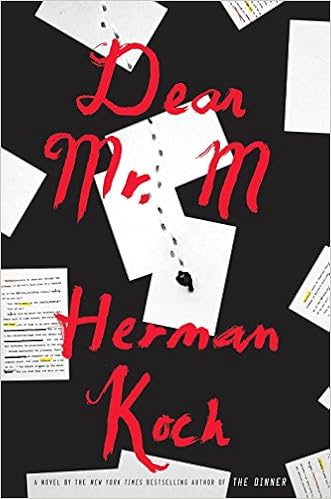4
Stars

This is a
“literary” thriller: it has a mystery to
be solved but also examines the literary world.
The book
opens with an unnamed narrator (later identified as Herman) stalking his
neighbour, a writer known as M. There is a definite undertone of menace as the
narrator makes statements like “Yes, I have certain plans for you, Mr. M” and
“I’m here, and I won’t be going away, not for a while yet” and “I consider you
a military target” and then proceeds to follow not just the writer but his
family. Gradually, it is revealed that in
his bestselling book, M used events from Herman’s adolescence and distorted
them to create an exciting plot. Using a
highly publicized case involving a teacher, Jan Landzaat, who went missing and
was never found, M distorted events in his fictionalization and basically portrayed
Herman and a friend as killers.
The novel
examines the connection between fact and fiction and the process of creating
and crafting a work of fiction. Does a
writer have the right to appropriate facts and use people as material for
fiction, especially if by rearranging events for the sake of the plot he
negatively impacts the lives of the real-life people involved? Herman certainly wants to exact retribution
because he feels M exploited his life. Authors
observe people and the world around them and inevitably incorporate them in
their work, but should they be allowed to do so with impunity? Writers are taught to eliminate coincidence
because “Coincidence undermines a story’s credibility” and “Coincidence ruins
the credibility of a writer” though “reality is glued together with
coincidence.” What if a coincidence is a
key factor in a real-life event and its omission totally distorts reality? Koch introduces his theme in a
tongue-in-check epigraph: “Anyone who
thinks he recognizes himself or others in one or more characters in this book
is probably right. Amsterdam is a real
city in the Netherlands.”
There is
considerable suspense in the book. Koch
uses a number of techniques to keep tension.
When action reaches a dramatic point, the perspective is abruptly shifted
to a different point of view. The
viewpoints of a number of characters are given, some in first and some in third
person narration, and there are frequent shifts between past and present. There is more than one unreliable narrator so
the reader is left to try and decipher the truth. And, yes, there are unexpected twists in the
plot.
One benefit
of the changing points of view is that the reader’s feelings about a character
change. Herman describes M as a fading,
mediocre writer who is narcissistic and exploitative. When M becomes the narrator and the reader
becomes privy to some of his thoughts and feelings, a more sympathetic picture
emerges. When the opinion of others is
added, like that of M’s wife, another dimension is added. By the end, M is fully developed. The same is the case for Herman; parts of his
personality are described by various people with whom he comes in contact. Flashbacks to his youth help round out his
character.
What is
interesting is how similar M and Herman are.
Herman accuses M of invading his life and stealing it for his purposes,
yet Herman does the same with his video camera.
He photographs people in personally devastating moments, invading their
privacy, and then mocks those people in a public way. There are other similarities: both have troubled pasts, both are jealous of
others who are more successful, and both have mean streaks that occasionally
come to the fore.
One aspect
I really enjoyed is the way characters mock others for things which worry
them. Herman constantly refers to
Landzaat’s long teeth and Landzaat agrees that “his own teeth weren’t exactly
his ace in the hole” but when he thinks of Herman he describes his teeth at
length: “And his teeth! His teeth were too weird to be true. To call them irregular would be putting it
mildly. Those front teeth that curved
inward and the open spaces between his canines and the molars behind made him
look like a mouse more than anything else.
A mouse that had been smacked in the teeth by a much bigger mouse. How could a girl be drawn to that? They were teeth that let the wind through, a
girl’s tongue would have a hard time not getting lost in there.” M is married to a much younger woman and
worries about growing older and being forgotten, yet M and his wife mock N, an
older colleague who always has a young woman on his arm, and M comments that
N’s “countless wrinkles and folds in his cheeks and around his eyes seem to
deepen even further – the landscape of gorges and deep valleys above which the
sun is now doing down.” Koch definitely
knows a lot about human psychology.
Readers who
enjoyed Koch’s previous books The Dinner
and Summer House with Swimming Pool
will certainly enjoy this one. There are
sections that I found a tad tedious – the discussion of Dutch politics and the
changing relationships among Herman’s various friends – but there is much to
recommend this book. Koch is an author
who pokes fun at authors but examines serious issues as well. And provides well-rounded characters and an
entertaining plot that keeps the reader guessing.
Note: I received an ARC of this book from the
publisher via NetGalley.
No comments:
Post a Comment